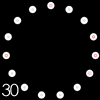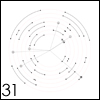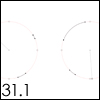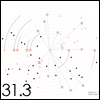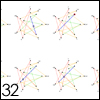Study no. 29 [Paper Pieces]
Performance Instructions
For paper.
Study no. 29 can be performed by as few as 2 players. There is no maximum.
The score application will generate a new iteration of the score each time it is refreshed. These iterations can be printed on any type of rippable paper.
Each player begins with one iteration of the score (one sheet). The score should be held in portrait orientation. Numbers along the right side of each of the 3 vertical lines denotes the number of *counts* the corresponding rip should last. A *count* can be of any duration, and each player determines their count duration independently. Numbers to the left of the black nodes denote a pause for that number of counts.
The score should be ripped from top to bottom.
There are 6 rip techniques that may appear in any given iteration of the score:
Solid straight line: Rip at a consistent speed and volume.
Triangle [increasing]: Rip at an increasingly fast pace.
Triangle [decreasing]: Rip at a decreasing pace.
Triangle [increasing/decreasing]: Rip at an increasingly fast pase for half the duration of that particular rip, then decrease rip speed to the end.
Dashed lines: Rip with a steady, pulsed rhythm.
Plussed lines: Rip with an unsteady rhythm.
The ensemble should be amplified to the point just below feedback.
Duration: As long as it takes for all players to get through at least one iteration of the score (one sheet).
Ryan Ross Smith, Fall 2013.
